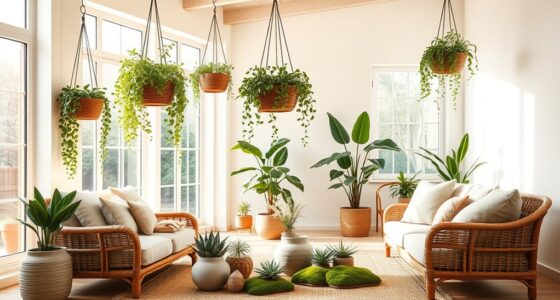The rise of slow fashion highlights why choosing quality over quantity matters. Instead of chasing fleeting trends, you can focus on durable, well-made pieces crafted with care and sustainable materials. This approach reduces waste, minimizes environmental harm, and promotes ethical production. By investing in versatile, timeless styles, you’ll enjoy clothing that lasts longer and aligns with your values. Want to learn how to build a conscious wardrobe? Keep exploring these essential principles.
Key Takeaways
- Slow fashion emphasizes durable, high-quality garments that last longer, reducing waste and environmental impact.
- Prioritizing quality over quantity supports ethical production, fair wages, and transparent supply chains.
- Investing in timeless, versatile pieces fosters mindful consumption and minimizes reliance on fleeting trends.
- Slow fashion promotes sustainable materials and craftsmanship, helping to lower pollution and resource depletion.
- Embracing slow fashion encourages a more responsible, conscious approach to clothing choices benefiting people and the planet.
Understanding the Slow Fashion Movement

While fast fashion encourages quick and cheap clothing, the slow fashion movement promotes a different approach focused on sustainability and quality. It’s about making thoughtful choices, investing in pieces that last, and valuing craftsmanship. Slow fashion emphasizes ethical production, fair wages, and environmentally friendly materials. Additionally, choosing durable clothing can help reduce the frequency of replacements and waste. Instead of chasing fleeting trends, you prioritize timeless styles and durability. This movement encourages you to shop less but better—buying fewer items that truly serve your needs and will stand the test of time. It also fosters a deeper appreciation for craftsmanship, which supports skilled artisans and preserves traditional techniques. This shift helps support responsible brands that prioritize transparency and environmentally conscious practices. By understanding slow fashion, you become part of a bigger movement that values longevity, transparency, and respect for both people and the planet. Recognizing the importance of quality over quantity can help you make more mindful purchasing decisions that contribute to a more sustainable future. Additionally, embracing ethical production practices ensures that your clothing choices support fair labor standards and environmentally responsible manufacturing. Developing an awareness of sustainable materials can further enhance your ability to choose eco-friendly options in your wardrobe.
The Environmental Impact of Fast Fashion

Fast fashion’s rapid production cycle and low prices come at a significant environmental cost. You may not realize that this quick turnaround leads to massive waste, as clothes are discarded after only a few wears. The industry relies heavily on synthetic fibers like polyester, which shed microplastics into waterways, harming marine life. Additionally, fast fashion consumes enormous amounts of water and energy, contributing to pollution and climate change. The use of toxic dyes and chemicals further pollutes rivers and ecosystems. When you buy cheaply made garments, you’re supporting a system that prioritizes speed over sustainability. This cycle results in overflowing landfills and environmental degradation, making fast fashion one of the largest contributors to global pollution. Furthermore, the growing popularity of glycolic acid products underscores a broader shift toward sustainable skincare alternatives that emphasize quality and longevity over disposable convenience. Incorporating slow fashion principles can help consumers make more environmentally conscious choices that support ethical production practices and reduce waste. Recognizing the importance of sustainable practices encourages a more responsible approach to fashion consumption, ultimately benefiting both the planet and future generations. Additionally, the rise of natural and organic materials in textiles highlights a move toward environmentally friendly options that lessen ecological impact. Promoting ethical manufacturing is essential for fostering transparency and reducing exploitation within the fashion industry.
Benefits of Prioritizing Quality in Clothing

Prioritizing quality in clothing offers numerous benefits that go beyond mere appearance. When you choose well-made pieces, you’ll notice they last longer, saving you money in the long run. High-quality fabrics and craftsmanship mean garments resist wear and tear, reducing the need for frequent replacements. This shift also minimizes waste, making your wardrobe more sustainable. Additionally, quality clothing often feels better against your skin and offers a better fit, boosting your confidence and comfort. You’ll spend less time sorting through piles of cheap, disposable pieces and more time enjoying versatile, timeless items. Investing in quality also aligns with sustainable fashion practices, which focus on promoting responsible and sustainable practices in the fashion industry. Understanding the material quality of your clothing helps ensure that you are making informed, durable choices. Recognizing the importance of slow fashion can encourage more mindful consumption and reduce environmental impact. Developing an eye for durability and craftsmanship can help you select pieces that truly stand the test of time. Ultimately, investing in quality helps you make more mindful choices, supporting a slower, more sustainable fashion cycle that benefits both you and the planet.
How to Identify High-Quality Pieces

To identify high-quality pieces, start by examining the fabric; look for smooth, tightly woven materials that feel substantial yet comfortable. Pay attention to craftsmanship—stitching should be even, secure, and free of loose threads or skipped stitches. Small details like reinforced seams and carefully finished hems also signal well-made clothing that will last. Recognizing industry trends and the attention to detail in construction can help ensure you choose pieces that are durable and worth the investment. Additionally, understanding home maintenance principles such as proper cleaning techniques can help extend the lifespan of your garments and keep them looking their best over time. Incorporating sound health practices, like avoiding harsh chemicals during washing, can further preserve the quality of your clothing.
Fabric Quality Indicators
When evaluating fabric quality, look closely at the material’s texture and feel. High-quality fabrics should feel soft yet substantial. They won’t be overly stiff or flimsy. Check for a natural sheen—satin or silk feel smooth, while cotton feels crisp. Examine the weave; tight, even weaving indicates durability. Avoid fabrics with pilling or loose threads. Use this table to compare fabric indicators:
| Indicator | High-Quality Material | Lower-Quality Material |
|---|---|---|
| Texture & Feel | Soft, smooth, dense | Rough, thin, uneven |
| Sheen | Natural, subtle shine | Dull or overly shiny |
| Durability | Resists pilling, maintains shape | Pills easily, loses form |
Focusing on these signs helps you pick pieces that last, aligning with slow fashion values.
Craftsmanship and Details
High-quality pieces showcase craftsmanship through meticulous attention to details like stitching, finishing, and construction. You can spot quality by examining how seams are sewn—tight, even stitches indicate skill. Look at the finishing touches, such as clean hems and smooth linings, which show care and precision. The construction of the item should feel sturdy, with no loose threads or uneven edges. Additionally, understanding key traits of successful quality assurance, such as attention to detail and consistency, can help you better assess the overall craftsmanship of the piece.
The Role of Ethical Production Practices

Ethical production practices are essential to the principles of slow fashion because they guarantee that every step of creating clothing respects both people and the planet. When you choose brands that prioritize fair wages and safe working conditions, you support workers’ well-being and dignity. Using environmentally friendly materials and reducing waste minimizes your fashion’s ecological footprint. Transparency in supply chains allows you to know where and how your clothes are made, fostering trust and accountability. By backing companies committed to ethical standards, you help shift the industry toward more responsible practices. This approach ensures your wardrobe aligns with your values, promoting sustainability and social justice. Supply chain transparency is a crucial aspect of responsible fashion, enabling consumers to make informed choices. Incorporating techniques such as mindfulness practices can help consumers become more aware of the origins and impact of their clothing choices. Implementing sustainable manufacturing techniques can further reduce environmental harm and promote ethical labor practices. Using eco-friendly materials like organic cotton or recycled fabrics also supports ethical and sustainable fashion practices. Ethical production practices are the backbone of slow fashion, making your clothing choices meaningful and impactful.
Tips for Building a Sustainable Wardrobe

Building a sustainable wardrobe starts with mindful shopping habits. Before making a purchase, ask yourself if the item will last and if it truly fits your style. Focus on quality over quantity by choosing well-made pieces that can be worn for years. Consider investing in versatile basics that pair easily with other items. Shop from brands committed to ethical practices and transparency. Repair and repurpose clothing whenever possible to extend its life. Avoid impulsive buying and instead, plan your wardrobe around your actual needs. Remember, slow fashion isn’t just about buying less; it’s about making smarter choices that benefit both the planet and your personal style. Incorporating spiritual decor elements like symbols or natural items can also inspire mindfulness in your shopping and wardrobe choices. Prioritize timeless, versatile pieces over fleeting trends. Choose natural fabrics like cotton, wool, or linen. Support local or small-scale ethical brands. Regularly assess and curate your wardrobe to prevent clutter. Additionally, paying attention to sustainable fashion practices can help you make more environmentally conscious decisions.
Embracing Timeless Style for Longevity

Embracing timeless style means selecting pieces that remain fashionable beyond fleeting trends, ensuring your wardrobe stays relevant for years to come. Focus on classic cuts, neutral colors, and versatile designs that can be dressed up or down. Avoid trend-driven items that quickly go out of style, as they often lead to waste. When you invest in quality basics like a well-fitting blazer, a crisp white shirt, or durable denim, you build a foundation for long-lasting outfits. Prioritize craftsmanship and materials that age gracefully, so your clothing continues to look good over time. By choosing timeless pieces, you reduce wardrobe clutter and support sustainable fashion. Ultimately, your wardrobe becomes a reflection of enduring style rather than passing fads, making your fashion choices both eco-friendly and elegant.
Frequently Asked Questions
How Does Slow Fashion Influence Local Economies and Small Businesses?
Slow fashion boosts local economies and small businesses by encouraging consumers to buy less but better. When you choose locally-made, high-quality items, you support local artisans and entrepreneurs, helping them thrive. This shift reduces dependency on mass-produced goods, fostering community growth. Your purchasing habits can create a ripple effect, strengthening local employment, sustainability, and craftsmanship, making your choices impactful for the area’s economic health.
Can Slow Fashion Be Cost-Effective for Everyday Consumers?
Sure, spending more on clothes every few months sounds like a great plan, right? But if you think slow fashion isn’t cost-effective, think again. You’ll buy fewer, higher-quality pieces that last longer, saving money in the long run. Plus, you might even stop wasting cash on constantly replacing cheap, trendy items. So, yes, slow fashion can actually be a smart, budget-friendly choice for your everyday wardrobe.
What Challenges Do Brands Face When Shifting to Slow Fashion Models?
When brands shift to slow fashion models, you might notice several challenges. They often face higher production costs and longer timelines, which can make pricing less competitive. Additionally, sourcing sustainable materials and establishing ethical supply chains require significant investment. You could also see resistance from consumers accustomed to fast fashion’s quick turnover. Despite these hurdles, many brands believe prioritizing quality and ethics creates stronger loyalty and long-term success.
How Does Slow Fashion Impact Fashion Innovation and Creativity?
You might think slow fashion stifles creativity, but it actually encourages innovation by pushing you to explore unique fabrics, timeless designs, and sustainable techniques. Instead of chasing trends, you focus on craftsmanship and quality, inspiring you to develop more meaningful, durable pieces. This approach fosters originality, allowing you to experiment thoughtfully and create distinct collections that resonate with conscious consumers who value authenticity over fleeting trends.
Are There Specific Certifications to Verify Ethical and Sustainable Clothing?
You can look for certifications like Fair Trade, GOTS (Global Organic Textile Standard), and B Corp to verify ethical and sustainable clothing. These labels guarantee that brands meet strict environmental, social, and labor standards. When shopping, check for these certifications on tags or product descriptions. They help you make responsible choices, supporting brands committed to transparency, fair wages, and eco-friendly practices, aligning with your values and encouraging sustainable fashion.
Conclusion
Think of your wardrobe as a garden—you can plant many quick-blooming flowers, or nurture a few resilient, beautiful trees that grow stronger over time. Choosing quality over quantity is like tending to these trees, ensuring they flourish season after season. By embracing slow fashion, you create a sustainable, timeless garden that reflects your values and style—lasting longer, growing richer, and making a meaningful impact for the planet.










